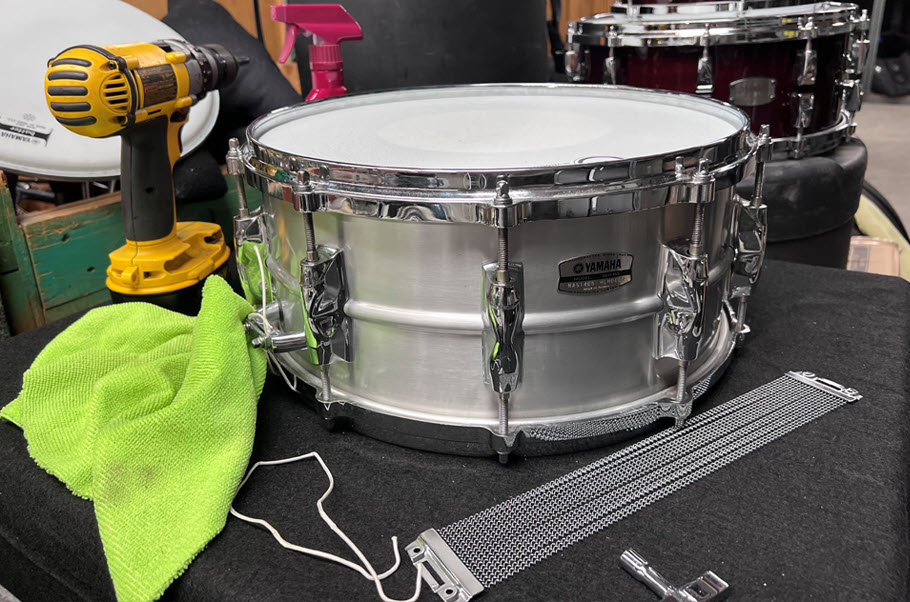Practice Exercises for the Beginning Drummer
Eight drills for your daily workout.
One of the keys to success on any instrument is consistent practice. If you make time every day to work on your chops, you’ll see much faster improvement than if you “binge” practice a few days a month. Setting aside 30 just minutes per day can help you make great improvements over the long haul.
In this article, we’ll present some basic exercises that can benefit any drummer. They provide a way to loosen up your drumming muscles while working on time, coordination and independence.
Practice these exercises along with a metronome, starting with a speed of around 70 BPM (beats per minute) for most of them. (All Yamaha electronic drum kits provide built-in metronomes.) If you feel that’s too fast for you, then by all means slow things down. These workouts are not about speed. They’re about producing deliberate drum strokes that are consistent in volume and timbre, and making sure they are locked in with the metronome.
When the patterns and coordination become second nature, you can speed them up. Don’t be frustrated by playing slowly. It’s actually a lot easier to play fast than it is to play slow, and starting slowly builds a good foundation.
We’ll use a bass clef for notation. A note on the first space indicates a kick drum stroke, and a note in the third space indicates a snare drum stroke:

The first five of these exercises are in 4/4 time, but the last three have different time signatures. As with any practice routine, try to find a quiet space where you won’t be distracted or interrupted.
1. Loosen Up Your Hands
Exercise 1 offers a good way to loosen up your hands. This is a single stroke roll, alternating one stroke from each hand, with a kick drum on the 1 and 3 of each measure to get your foot into the habit of playing the downbeat. Try to keep your hands at equal height above the snare drum, and snap your wrist back to the same starting position after each hit. Pay close attention to the timing on the 1 and 3 when the metronome, kick and snare all hit together, and listen carefully. You should not hear any flams:

2. Double Your Stroke
Exercise 2 is a variation on the double-stroke roll (“mama-daddy”), again with a kick drum on the downbeats. Listen carefully to the second stroke from each hand and make sure that it’s at the same volume as the first stroke from that hand. If the second stroke is softer or louder, make sure that your hand is returning to the same position every time:

3. Triplet Time
Exercise 3 is a triple stroke roll. Go for equal spacing between each stroke as well as tight timing between the hand and foot on the downbeats. You may find this exercise a bit easier than the previous ones because the quarter note is divided into three instead of two — meaning that there’s less time between each stroke:

4. Get Funky
Exercise 4 is the classic paradiddle. This is one of my favorites because once you’re comfortable doing it with both hands on the snare drum, you can move one hand to the high hat or ride cymbal, creating some funky grooves:

5. Kick That Funk
Exercise 5 is similar to Exercise 4 but adds a kick drum on the downbeats. This can throw some people for a loop because your foot will land with the opposite hand on the 3 of every measure, but it’s a good introduction to coordinating your limbs and getting out of the habit of always playing the right foot on the same beat as the right hand. Beware of the left hand not landing at the same time as the right foot (or vice versa for you left-handed drummers):

6. Swinging Waltz
Exercise 6 is the first one that doesn’t use a 4/4 time signature — instead, it’s in 3/4. You might notice that the suggested tempo is 140 BPM, which may sound kind of scary. But due to the change in time signature, 140 BPM is actually very manageable. When you start to get this one down, you’ll feel it swing like a waltz (ONE-two-three, ONE-two-three …). This is another drill where you can move one hand to different components of the drum kit and create some really interesting patterns. For example, try moving your right hand to the floor tom (left hand if you’re a lefty drummer) and see what happens!

7. Alternate Strokes
Exercise 7 is in 6/8 time, with a suggested starting tempo of 80 BPM. It helps develop your ability to alternate strokes between your hands and foot. This one is deceptively simple, with the tricky part coming at the end of measure 2 when the pattern repeats. That’s the spot where you may want to start the pattern again with your right hand — but be sure to start it with your left hand instead:

8. Get Independent
This last exercise builds on the previous one but drops the kick drum into the middle of the pattern. It helps build independence by moving notes between your hands and foot. This drill can take a bit more work than the other ones, so don’t worry if you need to slow down the tempo to get comfortable. Remember, it’s not about the speed.

You can use all of these exercises as a way to build your drumming abilities, but even when you’ve mastered them, they can be useful as a warmup for other practice routines. What’s even more fun is moving your hands around to different components of the drum kit, which can help you create some very cool grooves and fills.
Click here for more information about Yamaha electronic drum kits.














